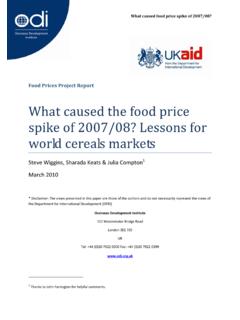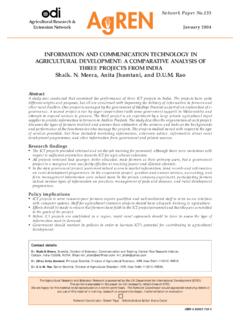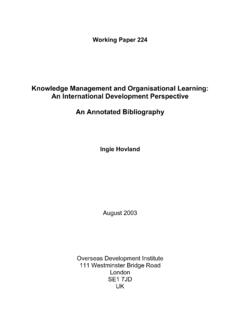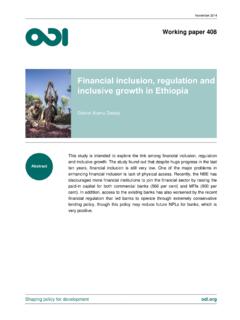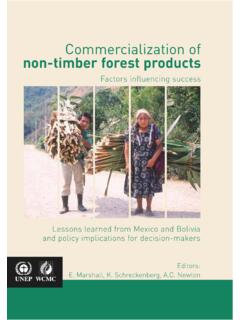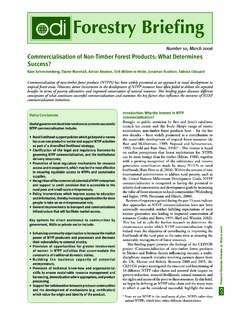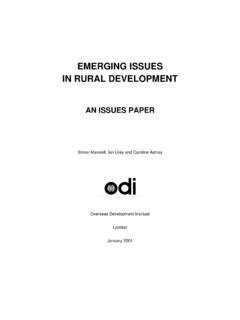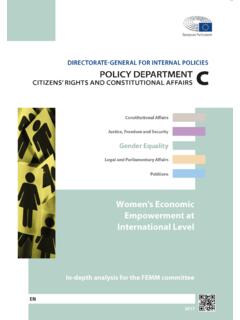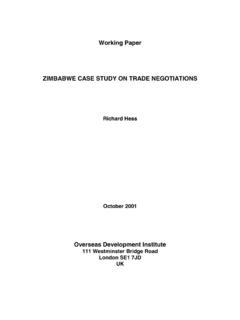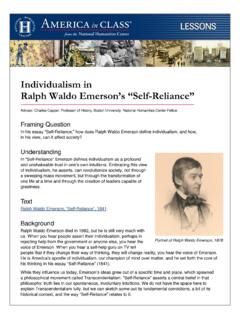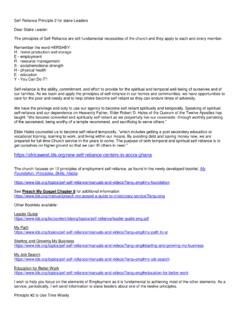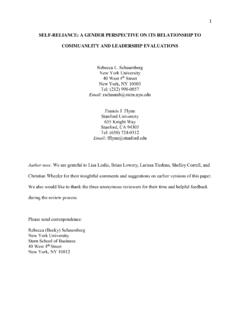Transcription of Nicholas Crawford, John Cosgrave, Simone Haysom and …
1 Protracted displacement: uncertain paths to self - reliance in exileNicholas Crawford, John Cosgrave, Simone Haysom and Nadine Walicki September 2015 HPG Commissioned ReportHPGH umanitarianPolicy GroupUK aid branding guidanceJune 2014 About the authorsNicholas Crawford is a Senior Research Associate for the Humanitarian Policy Group (HPG) at the Overseas Development Institute (ODI). John Cosgrave is an independent consultant. Simone Haysom is an independent Walicki is a Senior Regional Analyst at the Internal Displacement Monitoring Centre (IDMC).AcknowledgementsThe authors would like to express their appreciation to other members of the study team for this paper: Roger Zetter, Professor Emeritus in Refugee Studies at the Refugee Studies Centre, University of Oxford, provided extremely useful guidance and ideas throughout; Irina Mosel at HPG likewise was a steady source of helpful suggestions and support; research assistants Angela Pilath and Jane Chun helped organise and synthesise the literature review; and Ruvini Wanigaratne at HPG provided organisational support.
2 Many thanks also to Matthew Foley at HPG for his invaluable editing. Thanks also to the staff at IDMC for their many inputs, including Alexandra Bilak, Anais Pagot, Melanie Kesmaecker-Wissing and Justin Ginnetti. Finally, thanks to the staff at DFID who commissioned the report and provided comments and advice at various stages, as well as to Ewen Macleod at UNHCR and Niels Harild at the World Bank, who helped DFID shape the study and provided the research team with valuable inputs. This study was funded by the Humanitarian Innovation and Evidence Programme of the UK Department for International Policy GroupOverseas Development Institute203 Blackfriars RoadLondon SE1 8 NJUnited KingdomTel. +44 (0) 20 7922 0300 Fax. +44 (0) 20 7922 0399E-mail: Overseas Development Institute, 2015 iExecutive summary 1 Introduction 5 Section 1: Protracted displacement: dimensions, trends, characteristics Displacement today: trends and geographic distribution Protracted displacement International attention to situations of protracted displacement 15 Section 2: Literature review part 1 17 Promoting self - reliance and livelihoods in protracted displacement Overview Three theories of change The policy environment The perspectives of the displaced The architecture of the international system Unrealised theories of change and guarded optimism 29 Section 3: Literature review part 2 31 self - reliance and livelihoods interventions: what works?
3 Determinants of self - reliance and productive livelihoods 31 Programmes, lessons and good practice in self - reliance 33 and livelihood interventions Section 4: Identifying opportunities for self - reliance and livelihood programming 39 Conclusion 43 References 45 Contentsii Protracted displacement: uncertain paths to self - reliance in exile 1 Globally, forced displacement1 has been growing rapidly over the last decade, increasing on average by million people a year from 2000 2014. The number of displaced people around the world at the end of 2014 stood at million; internally displaced people (IDPs), who comprised just under 50% of the total displaced caseload in 1989, have accounted for over 60% of all displaced since countries produced over half of the million displaced people at the end of 2014. Syria alone was the origin for nearly one in five. Likewise, although more than 160 countries hosted displaced people in 2014, a small number bear the burden of hosting large populations: four countries Syria, Colombia, Iraq and Sudan are hosting 52% of all IDPs, while seven Syria, Iran, Pakistan, Lebanon, Turkey, Palestine and Jordan are hosting more than 50% of all refugees.
4 The majority of refugees and IDPs have been displaced from, within or into countries with serious protection, human rights and governance weaknesses. Roughly 36 million out of a total of million displaced people (60%) originated in countries categorised on the Fund for Peace s Fragile States Index as alert and high alert , while 48% of all displaced were exiled in countries falling into those is increasingly an urban and dispersed phenomenon, with settled camps becoming the exception. At least 59% of all refugees are now living in urban settings, a proportion that is increasing annually. The majority of IDPs are likewise outside identifiable camps or settlements, and instead live dispersed in urban, rural or remote displacement crises will persist for many years. A rapidly resolved crisis of any significant proportions is a rare exception. Data from 1978 2014 suggests that less than one in 40 refugee crises are resolved within three years, and that protractedness is usually a matter of decades.
5 More than 80% of refugee crises last for ten years or more; two in five last 20 years or more. The persistence of crises in countries with internal displacement is also notable. Countries experiencing conflict-related displacement have reported figures for IDPs over periods of 23 years on average. Understanding the likelihood of protractedness from the outset and well before the five years that is the current UNHCR threshold for protracted refugee situations should influence the shape and duration of national and international as most displacement crises persist for years and even decades, most refugees and many IDPs living in those situations can expect to be in exile for many years. Once displaced for six months, refugees have a high probability of finding themselves in displacement for at least three years and often much longer what this study defines as protracted displacement . Over the past decade, about 80% of refugees around the world were in a state of protracted displacement at any one time.
6 At the end of 2014, two-thirds of all refugees, or million people, were stuck in protracted displacement a slightly lower proportion as a result of new refugees from Syria. Half of all refugees had been in exile for over ten years at the end of 2014. In 2011, prior to the large number of new refugees from Syria, half of all refugees had been in exile for over 22 years. Protracted displacement among IDPs is also a major phenomenon: in two-thirds of countries monitored for conflict-induced displacement in 2014, at least 50% of IDPs had been displaced for more than three years. Global support for all situations of displacement (short and protracted) was estimated to total $ billion in 2014, or 50% of total global humanitarian spending that year. Roughly half of all global spending on displacement, or $ billion, was directed to situations of protracted displacement. Ten countries Syria, Colombia, Iraq, Pakistan, Sudan, the Democratic Executive summary1 Displacement in this paper refers to people who are forcibly displaced as a result of armed conflicts, situations of generalised violence, violations of human rights or natural or human-made disasters.
7 This includes refugees, IDPs and other persons of concern to UNHCR, such as asylum-seekers and stateless people (UNHCR, 2012b). Historical data for IDPs for the period covered by the study is only available for those displaced by conflict and generalised violence. The totals for IDPs may include people who have been displaced by some combination of natural disaster and political instability or other causes. 2 Protracted displacement: uncertain paths to self - reliance in exileRepublic of Congo (DRC), Jordan, Turkey, Palestine and South Sudan hosting roughly 37 million displaced people ( of the total), absorbed about 37%, or $ billion, of all humanitarian spending in 2014. These same ten countries hosted of all refugees in protracted an exact picture of the global state of protracted displacement is an approximate and incomplete exercise in part because each situation of protracted displacement is its own unique and complex system: layers of new, old or oft-displaced people; a sometimes indistinguishable mix of refugees, IDPs, migrants and host populations; a mishmash of wildly differing needs and social and human capital amongst the displaced and their hosts; and opaque systems of support sometimes international, more often local and informal.
8 Improving the mapping and monitoring of protracted displacement calls for improvements in donor, agency and national government data and reporting systems. Further investment is particularly needed to count and track caseloads of IDPs, as in many cases neither governments nor the UN is regularly reporting such figures. For both protracted refugees and IDPs, even country-specific estimates of the numbers of urban and rural displaced people or the numbers of those encamped or self -settled need to be improved. Finally, existing donor and agency reporting systems do not account directly for the amount of international aid being directed towards displacement, protracted or otherwise, making it difficult to estimate levels of agencies seeking to promote self - reliance and livelihoods amongst people in protracted displacement have progressed from models of assistance largely focused on care and maintenance (with indirect but potentially important outcomes for long-term livelihoods) towards a more holistic response to the challenges and opportunities available to displaced people.
9 Because of insufficient or inconsistent funding, care and maintenance regimes generally have not provided a stable platform on which beneficiaries could progress towards self - reliance . They also seem to have fallen short in contributing to lowering chronic malnutrition an indicator of lost future economic potential. When it comes to more direct interventions to support self - reliance and livelihoods, such as vocational training and income generating projects supported by grants and loans, the research literature reveals a panoply of small-scale uncoordinated and unsustainable interventions, mostly implemented by the humanitarian arms of aid agencies, with inadequate technical and managerial expertise, poor links to markets and short-term and unreliable the same time, the research literature does suggest improvements in the diagnostics around self - reliance and livelihoods in protracted displacement. As protracted displacement has become the norm, analysts and aid professionals have developed a more complex understanding of the kinds of environments policy, political, economic and geographical that can encourage self - reliance and sustainable livelihoods among the displaced, as well as the characteristics of displaced people that favour or discourage positive economic integration.
10 Much of this improved diagnosis has been spurred by a pragmatic acceptance that displacement will be prolonged (and that options for traditional durable solutions are often closed), which in turn has led to a better appreciation of how market forces and the connectedness of displaced people amplified by their social capital have allowed them in some contexts to achieve positive livelihood outcomes. Central to this shift in understanding has been a focus away from an aid-centric view of livelihoods in displacement that the livelihoods of displaced people depend on external interventions to an appreciation of the steps displaced people themselves are taking to find their way, and the support they may need to sustain these initiatives. Evidence that the economic dynamism of displaced people can have positive effects for host populations and states has also led to a consensus around advocacy for displaced people: encouraging access to livelihoods ( work permits or freedom of movement) is not just a human rights issue, but also offers practical economic and social returns an argument, however, that has so far borne few positive results in host states, whose behaviour continues to be shaped by domestic political if host states and local administrations have been slow to embrace more enabling policy frameworks, humanitarian and development agencies have begun to introduce programmes in support of self - reliance and livelihoods that appreciate the complexity of livelihood strategies open to displaced people, the barriers they face and the steps they are taking on their own.
